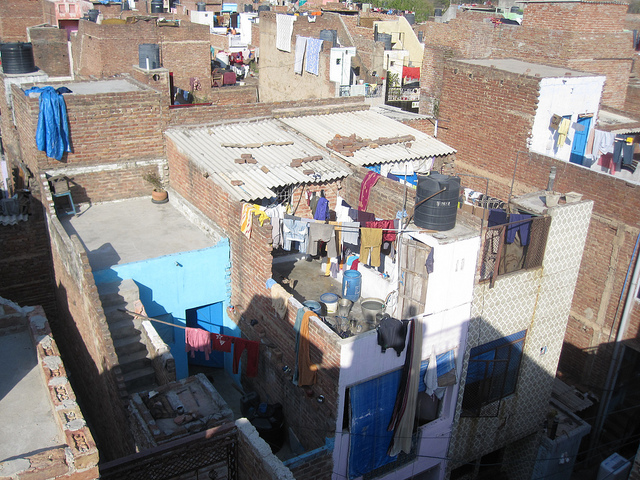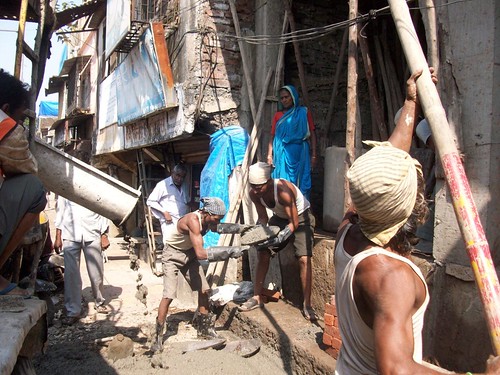#GC2022 is accepting submissions - 25d 27h 05m 44s
1. Vulnerable Urban Age

Building in construction, Khar West, Mumbai. Photo by Priyanka @ urbz
We live in a vulnerable urban age – where many ambitions of the twentieth century seem to be coming apart. According to David Harvey, the connections between the financial crisis and urban "development" are very real. He connects it to the financial mismanagement of the real estate market, and also projects it on a larger story of urban politics. Today – bursting of real estate bubbles in Dubai, decaying infrastructure in the US, social unrest in London, are all part of the same story. We take as our starting point this vulnerability of the urban world that we accept as the normative.
2. Post-Planning World

Add-on to Micro-Rayon Housing Projects, Moscow. Photo by Francisca Insulza, Merve Yucel and Evgeniya Nedosekina (Strelka).
One very important political goal that was expressed in urban civic terms in the twentieth century imagination was reducing inequality and providing a decent standard of living for as many sections of society as possible. Social housing projects in Europe and America were one manifestation of this social concern – but its highest point of achievement was in the Soviet Union. Today 70% of the population in the capital city of Moscow live in mass housing projects. However, In contemporary Moscow too we see how such projects have been overgrown by the post-planned city where structures and homes have been extended and personalized.
3. The Natural City

House in Dharavi, Mumbai. Photo by anonymous KRVIA student.
The emerging economies of today – especially Brazil, India and Africa – are responding to the same impulses and imperatives as the post-planned city in Russia, US or Europe. The form that dominates much of the new urbanscape is what is often misrepresented as slums or the informal city. We refer to this as the natural city. The natural city is a urban cyborg, in a constant process of simultaneous decay and regeneration. It is neither pure nor perfect. Often polluted, corrupted and toxic itself, it is simply a manifestation of certain irrepressible processes of urban growth. It flourishes anywhere planning fails. This failure is itself an expression of the fact that the natural city was denied a legitimate expression. This dominant urban form that Mike Davis evokes as engulfing the planet in the 21st century is our point of inspiration and departure.
4. Local Expression

Artamis. Former campus of the industrial services of the city of Geneva, it was squatted for many years and had become a nodal point of the city’s cultural life until occupants were evacuated. Photo by airoots.
We see it as energized by what anthropologist Arjun Appadurai refers to as the production of locality – a process that is determined by collective agency and will and which makes people participate wholly in the production of their environments. It is a process which is often negated or even actively repressed by the state, which in the twentieth century even in non-socialist countries, was epitomised by the desire for total urban planning and control. The frustrated impulse to produce locality manifests itself in all kinds of ways: urban counter-cultures in developed societies, underground markets, parallel economies and of course habitats that emerge in the shadow of the planned environments.
5. Vernacular Absorption

New Delhi: Mongolpuri, Sawda Ghevra. Photo by urbz team.
The natural city absorbs all materials and ideologies, becoming a vernacular expression in every locality – feeding off the negentrophic tendency of systems that internally mitigate their imbalances and dysfunctionalities. Much like the hunter-gatherer societies that live outside the boundaries of controlled civilizations and create wealth and culture on their own terms, the natural city creates its own systems of transactions. It is at once deeply connected to the powerful state-level and global forces that try to control it, but also, to some extent, able to mitigate their local reach. Where they are forced to express themselves in large numbers as so-called informal settlements they are constantly threatened by the state-crafted ideology of planning which itself has actually lost steam in many parts of the world. An ideology that does not pay adequate attention to the special form of the natural city based on creative spatial arrangement of space, time, functions and relationships.
6. City Users – City Makers

Construction site in Shivaji Nagar, Deonar, Mumbai. Photo by urbz team.
Out of the agents that energise and produce the natural city, the post industrial artisan, the local contractor and the hardware dealer, are key characters. The local contractor is at once businessman, community player and a possible political figure. He knows the nuts and bolts of his constantly forming environment like no one else. We see him as part of the larger story of urban based class struggle that David Harvey talks about. According to Harvey, the city is no more the site where the factory exists but is – in lieu of the factory – itself the agency of production and also the product itself. It consists of the alienated worker in the planned discourse and the relatively less alienated figure – a bit like a post-industrial artisan – the contractor, his team of workers and network of collaborators. (We are aware this is a huge departure of the narrative presented but feel that this trajectory of thought is worth following as well.)
7. Freedom of Expression, Imagination and Action

March against the redevelopment of Shimokitazawa, an unplanned locality in the centre of Tokyo. Photo by Save the Shimokitazawa.
Eventually the Natural City – as a universal expression with its vernacular- local ammunition is a creative moment. It is sad that in the world of urban futures the practice of making cities has not allowed – in fact has actively suppressed – the ability and desire of people to allow themselves a form that is economically and culturally liberating even though at present tends to be civically deprived in many manifestations.
This story first appeared at the presentation at the Politecnico de Torino, December 1st, 2011
Originally published in airoots/eirut